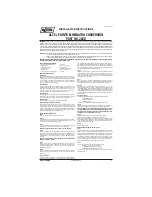
Daimler Communications, 70546 Stuttgart, Germany
Mercedes-Benz – A Daimler Brand
Page 12
Air/water intercooler for optimum engine efficiency
A typical feature of the AMG biturbo V12 engine is the sophisticated air/water
intercooler. A large cooler at the front of the vehicle effectively cools down the
intake air – which has been compressed by the turbochargers – before it enters
the combustion chambers. The water-cooled low-temperature cooler results in a
25 percent reduction in intake temperature at full throttle and guarantees high
power and torque output under all operating conditions and regardless of the
outside temperature. The housings of the compressor and turbine in both turbo-
chargers as well as the turbine and compressor wheels have been enlarged,
resulting in a maximum charge pressure of 1.5 bar.
The electronically controlled AMG-specific fuel supply operates with a variable
system pressure of between 3.6 and 5.0 bar. According to power requirements and
external temperature, fuel pressure is variably controlled almost instantly. The
engine management system translates the command from the accelerator within
milliseconds, delivering an extremely fast response from the engine in all load
situations. The sports exhaust system with two sets of twin chromed tailpipes in the
V12 design provides the telltale AMG twelve-cylinder vocals on the new S 65 AMG.
Engine production at Mercedes-AMG: tradition of hand-built excellence
Traditionally all engines are built by hand at Mercedes-AMG in Affalterbach – just
like the AMG 6.3-litre V8 engine in the S 63 AMG and the AMG 6.0-litre biturbo
V12 engine in the S 65 AMG. In the state-of-the-art AMG engine workshops, which
were opened in 2002, a highly qualified engineer assembles each engine according
to the company's philosophy of "one man, one engine" in compliance with the most
stringent quality standards. The engineer's signature on the AMG engine plate is
testimony to the highest standards of workmanship. It takes around three hours to
produce the V8 engine; the V12 unit normally takes somewhere in the region of
six-and-a-half hours.













































